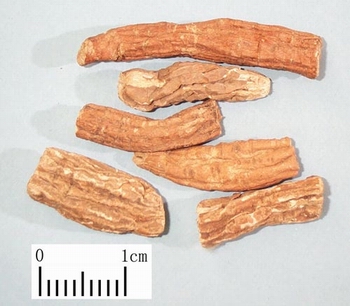Jing Da Ji
The Processing of Jing Da Ji
Origin
The root of Euphorbia pekinensis Rupr. of family Euphorbiciceae.
Location
Mainly in Jiangsu, Sichuan, and Guangxi provinces, etc. of China.
Harvest
Collected in spring and autumn.
The actual smell and taste
Light smell, slightly bitter and astringent taste.
Best quality
Well-distributed root, fat, and soft without rootlet.
Processing
Unprocessed or processed with vinegar.
The Effect of Jing Da Ji
Property
Bitter, cold, toxic, large intestine, lung, and kidney meridians entered.
Actions
Drive out accumulated water, relieve swelling and dissipate nodulation in topical application.
Indications
A. Edema, tympanites and hydrothorax
It has a similar but less drastic action than that of Gan Sui, and commonly indicated for edema, tympanites and hydrothorax without deficiency of original qi. It is often combined with Gan Sui and Yuan Hua, as in Shi Zao Tang from Shang Han Lun.
B. Sores and abscess
It has the action of relieving swelling and dissipating nodulation when being used topically. For sores and abscess due to heat-toxin, the fresh root can be applied externally after pounded, or used in combination with the herbs of removing toxicity, curing abscess, and dissipating nodulation.
Dosage and Administrations
0.5~1g used in pills or powder for each time. Proper dosage is for topical administration. It should be processed with vinegar to weaken its toxins when taking orally.
Cautions
It is contraindicated to pregnancy and valetudinarian, and antagonistic to Gan Cao.
